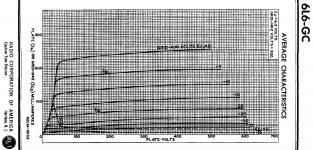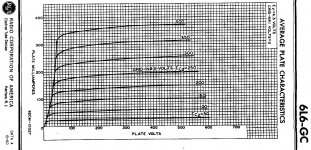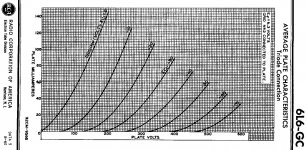Ok, So I started working on a set of normal RH807se mono's, built the first channel, got it up and running (ruff layout, long wires, ect) It sounded like it lacked wattage/volume, ran back to the psu simulator, found out I needed ruffly 75uf on the tail end of my B+ supply (500v) added that, the amp woke up, made tons of usable wattage, and over all impressed the heck out of me.
Later that day I pulled it apart, so I could do the point to point wiring and tidy up all the long wires, did that, and warmed things up for sound test 2, huge issue, preamp needs to be turned to 11 to get ANY sound output, so I took the 807 tube out, disconnected the ECC81 from the 807 grid, turned on the 270v supply (for the screen of the 807, and the plate of the ECC81) and hooked a 1w speaker to the coupling cap's tail end, ground went to chassis ground, and under super high preamp volume levels, got distorted music!
Changed driver tubes about 3 dozen times (not kidding) with known good tubes, everything from telefunken 12at7's to clear top 12au7's, all the way to long plate 3 rib 12ax7's, same condition, took high volume to get anything out of the coupling cap's back end, so then I put a 1m resistor from the coupling caps "out-put" to ground, no change.....
Took the socket out, cleaned it, replaced the 300ohm cathode resistor, new 1m input resistor, new wima 2.2uf coupling cap (also tried a few other coupling caps) and the same issue persisted...
I'm lost...
Later that day I pulled it apart, so I could do the point to point wiring and tidy up all the long wires, did that, and warmed things up for sound test 2, huge issue, preamp needs to be turned to 11 to get ANY sound output, so I took the 807 tube out, disconnected the ECC81 from the 807 grid, turned on the 270v supply (for the screen of the 807, and the plate of the ECC81) and hooked a 1w speaker to the coupling cap's tail end, ground went to chassis ground, and under super high preamp volume levels, got distorted music!
Changed driver tubes about 3 dozen times (not kidding) with known good tubes, everything from telefunken 12at7's to clear top 12au7's, all the way to long plate 3 rib 12ax7's, same condition, took high volume to get anything out of the coupling cap's back end, so then I put a 1m resistor from the coupling caps "out-put" to ground, no change.....
Took the socket out, cleaned it, replaced the 300ohm cathode resistor, new 1m input resistor, new wima 2.2uf coupling cap (also tried a few other coupling caps) and the same issue persisted...
I'm lost...
Last edited:
Hmmm... Is that binding post where you solder the other end of your coupling cap isolated from ground?
Indeed it is Wavebourn, even tried with the coupling cap just "hanging" there!
whats weird is when the amp exhibited this problem the first time, a wiggle here or there would resolve the issue, After much thought, and vodka, I think this is coming down to a dirty socket, since a resistor swap, and coupling cap swap did NOTHING for the issue.
Though I might come back tomorrow after a new day has started, only to profess my ignorance!
I am correct in thinking the noise coming out of the coupling cap, should be as high, if not higher then my preamp, correct?
whats weird is when the amp exhibited this problem the first time, a wiggle here or there would resolve the issue, After much thought, and vodka, I think this is coming down to a dirty socket, since a resistor swap, and coupling cap swap did NOTHING for the issue.
Though I might come back tomorrow after a new day has started, only to profess my ignorance!
I am correct in thinking the noise coming out of the coupling cap, should be as high, if not higher then my preamp, correct?
Naturally, I'm a cisco network engineer/programmer by trade 🙂
By noise, I mean sound, but since my sound is not passing through my output tube, it might as well be noise?
By noise, I mean sound, but since my sound is not passing through my output tube, it might as well be noise?
Voltage out of the coupling cap was in the range (fluctuating) of +50mv to -170mv, this changed from tube to tube (12au,at,ax7's)
tested a few coupling caps, had a black beauty that was spitting out +50v 🙁
tested a few coupling caps, had a black beauty that was spitting out +50v 🙁
An externally hosted image should be here but it was not working when we last tested it.
Last edited:
I'm lost...
1. You had a working prototype. You had known good components.
2. You tore it apart and rebuilt it.
Go back to a working prototype build and then make one tidy-up at time. Or undo each step backward toward the prototype build, testing each backstep until it's working again.
Also, you cannot expect each tube variant to perform the same in the circuit. Those 12xx's have different amplification factors. Use the scientific method in troubleshooting by making only one change at a time between tests.
Don't rule out tiny solder splashes or bridges.
An externally hosted image should be here but it was not working when we last tested it.
Imagine that schematic, minus 1 of the 807's, R6 was eliminated, trimmer on the bias supply is now 50k, input into the bias supply is now 20vac (had no need for the amount of bias a 72v supply gives) the single 807 when running operated @ 32ma cathode current.
Resolved the issue, 3 min's on the phone with Anatoliy solved the mystery! (it was a miracle the amp worked at all)
Anatoliy, you rock! Next time you come to las vegas, I have a treat for you.
Last edited:
Having looked at the schematic (saved on my computer, loaded into Paint, zoomed "large size" 400% so I can read the small font in low-contrast colors) and followed your description of mods I'm pretty sure I now see what the problem was (it appears to have everything to do with excessive signal loading of the 12AT7 output through the 807's bias circuit - even in the original circuit, R6 looks to be three orders of magnitude lower than it ought to be), but since you say you "resolved the issue" it would be good if you actually told us exactly what it was. A simple "I had done this instead of that" would be great.
Having looked at the schematic (saved on my computer, loaded into Paint, zoomed "large size" 400% so I can read the small font in low-contrast colors) and followed your description of mods I'm pretty sure I now see what the problem was (it appears to have everything to do with excessive signal loading of the 12AT7 output through the 807's bias circuit - even in the original circuit, R6 looks to be three orders of magnitude lower than it ought to be), but since you say you "resolved the issue" it would be good if you actually told us exactly what it was. A simple "I had done this instead of that" would be great.
In the supplied schematic,I don't see a plate load resistor on the first tube! (12AT7) (I'm assuming the 100K is feedback,and the "265V" is the plate supply for the 12AT7.)
No, the 100k is the plate load resistor, B+ feeds the 12at7 in this configuration.
100k would likely be ok, the reason the designer used the 470k was to drop off some of the radical voltage his 70v bias supply would produce, I went with 20vac for the supply, and only needed the 4.7k resistor to do its job.
The fix to my amp, was as simple as taking the 270v B+2 wire off the anode of the 12at7, and letting B+1 power the tube, properly. since I was defeating the anode load resistor.
Oh, and the working voltages of the amp are as follows.
560v B+1
270v B+2
100k would likely be ok, the reason the designer used the 470k was to drop off some of the radical voltage his 70v bias supply would produce, I went with 20vac for the supply, and only needed the 4.7k resistor to do its job.
The fix to my amp, was as simple as taking the 270v B+2 wire off the anode of the 12at7, and letting B+1 power the tube, properly. since I was defeating the anode load resistor.
Oh, and the working voltages of the amp are as follows.
560v B+1
270v B+2
Having looked at the schematic (saved on my computer, loaded into Paint, zoomed "large size" 400% so I can read the small font in low-contrast colors) and followed your description of mods I'm pretty sure I now see what the problem was (it appears to have everything to do with excessive signal loading of the 12AT7 output through the 807's bias circuit - even in the original circuit, R6 looks to be three orders of magnitude lower than it ought to be), but since you say you "resolved the issue" it would be good if you actually told us exactly what it was. A simple "I had done this instead of that" would be great.
Cant do much with the schematic size, that's how It came to me from the guys website. 😉
- Status
- Not open for further replies.
- Home
- Amplifiers
- Tubes / Valves
- Weird issue with tube driver.


